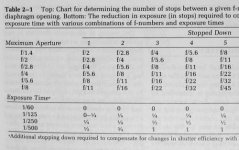pvdhaar
Peter
Spot on, there are so many factors involved...if we don't know how the shutter speeds were measured: if it was the duration starting from a small opening, it's not quite so dramatic, if the time the shutter was fully open, or the effective exposure was measured, then your shutter is really slow.
At fast shutter speeds, the time the shutter is traveling compared to it being fully open becomes relatively larger. That goes one way. But, on the other hand, the shutter doesn't often really reach its advertised speed, and that goes the other way. With an aperture that is closed down and effectively taking away from the relative contribution in time that the shutter spend traveling in the mix, everything goes.
That may also explain why some camera and lens combinations are affected and others not like FujiLove mentioned..
seany65
Well-known
Ranchu, could you please post new thumbnail that leads to a bigger photo? The prsent pic isn't quite big enough for me.
Dwig
Well-known
Shutter blade design can have a significant impact on this issue.
While no purely mechanical shutter and separate iris can actually compensate, some shutters are less affected than others. If the blades open much like an iris, the speed difference at the top speed, between full aperture and a small aperture, can be significant, as the chart shows. If the blades are shaped and articulated so that they open along the overlapping seams between blades, producing a spiked star pattern when partway open, their efficiency is more uniform across a range of apertures, though never completely uniform.
The common "program automatic" exposure systems have frequently used a single set of blades to act as both shutter and iris. These, by design, effectively compensate.
While no purely mechanical shutter and separate iris can actually compensate, some shutters are less affected than others. If the blades open much like an iris, the speed difference at the top speed, between full aperture and a small aperture, can be significant, as the chart shows. If the blades are shaped and articulated so that they open along the overlapping seams between blades, producing a spiked star pattern when partway open, their efficiency is more uniform across a range of apertures, though never completely uniform.
The common "program automatic" exposure systems have frequently used a single set of blades to act as both shutter and iris. These, by design, effectively compensate.
raid
Dad Photographer
This is very interesting. Thanks for letting us know.
Ranchu
Veteran
My pleasure, Raid, I was surprised! And thank you, Dwig for that interesting information..
BillBingham2
Registered User
Never heard of it, wow, interesting.
The thing that boggles my mind is that 'Blads have leaf-shutters and I never heard of anyone adjusting.
Thank you sir!
B2 (;->
The thing that boggles my mind is that 'Blads have leaf-shutters and I never heard of anyone adjusting.
Thank you sir!
B2 (;->
Ranchu
Veteran
Happy it helps, sir!
Sorry, the max is 600px wide to upload to rff? The chart is the same as the apertures increase, except at 1/60th, it says "0-1/4" for f11, f16, and f22. It comes from Basic Photographic Materials and Processes, which I can recommend to anyone. Mine's the second edition, which is fine and cheap.
Ranchu, could you please post new thumbnail that leads to a bigger photo? The prsent pic isn't quite big enough for me.
Sorry, the max is 600px wide to upload to rff? The chart is the same as the apertures increase, except at 1/60th, it says "0-1/4" for f11, f16, and f22. It comes from Basic Photographic Materials and Processes, which I can recommend to anyone. Mine's the second edition, which is fine and cheap.
Attachments
retinax
Well-known
Just slightly off topic, as the cause of this is the same: Being slow enough to influence exposure, the opening and closing of leaf shutters also has an effect on "boke". Someone has made a comparison here: https://photographylife.com/fuji-gfx-50s-vs-hasselblad-x1d-50c .
While to oof highlights are clearly affected, I cant see a difference in oof lines. Theoretically, I think they should look as if the picture was overlayed with a picture made with a smaller aperture, because part of the exposure happens at essentially a smaller aperture. Why is that not more visible?
While to oof highlights are clearly affected, I cant see a difference in oof lines. Theoretically, I think they should look as if the picture was overlayed with a picture made with a smaller aperture, because part of the exposure happens at essentially a smaller aperture. Why is that not more visible?
seany65
Well-known
Thanks for the bigger table Ranchu.
johnnyrod
More cameras than shots
Interesting read, thanks Ranchu. To echo some things said above, the actual shutter speeds of older leaf shutters are going to be slow. Without getting mired in details of exact measurement, yes an error of 20% in the shutter speed would be considered acceptable - which is nearly half a stop. In reality even a serviced shutter will be slow at the top speeds, often running at half the expected speed, so 1/500 is more like 1/300, and they can vary a fair bit on shutters where the top speed is essentially unregulated (the mechanism is simply running as fast as possible) so it could be 1/250 up to 1/320 for example. I guess slide film is very finicky but negative film less so; I tend to ignore the "real" speed so it overexposes a bit, but at least pay attention in terms of the motion shake aspects. Shooting at 1/25 which is really 1/15 may not be possible hand-held, or you may choose a higher speed because you know that 1/125 is really 1/70 or whatever, so not fast enough for the subject.
Share:
-
This site uses cookies to help personalise content, tailor your experience and to keep you logged in if you register.
By continuing to use this site, you are consenting to our use of cookies.

